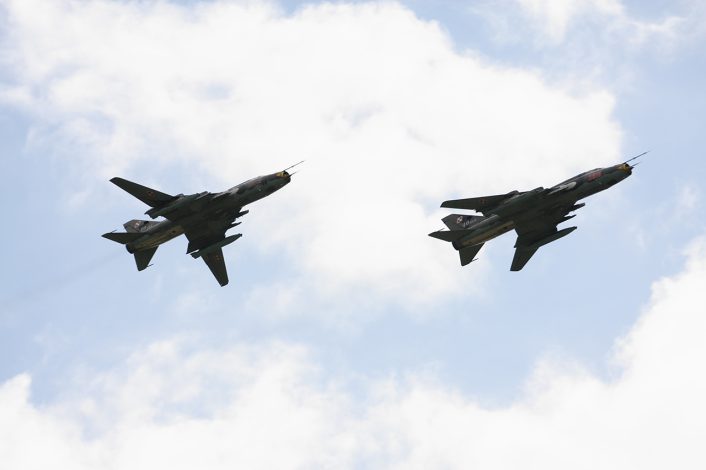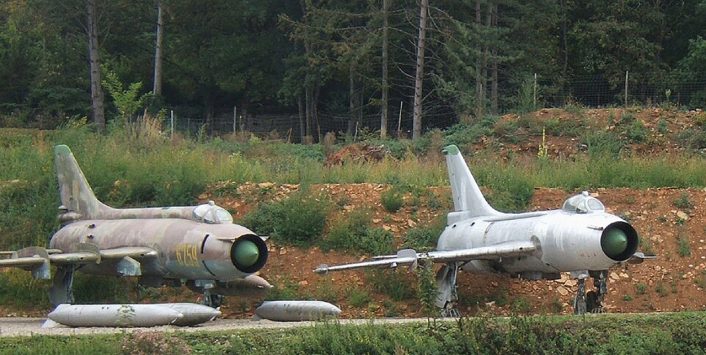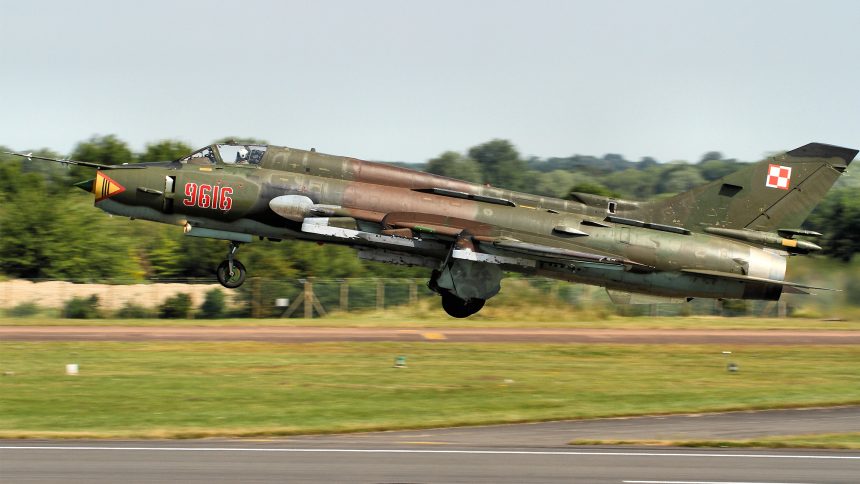This week, over 40 years after entering service, the swing-wing Su-22 Fitter fighter bomber was withdrawn from the Polish Air Force in a farewell ceremony held at Mirosławiec.
The Su-22’s sundown has been imminent since the final decision to retire the fleet was announced by the Chief of the General Staff of the Polish Armed Forces in March 2025. With the modern KAI FA-50 now in service with the Polish Air Force, and F-35 Lightning IIs on the way, the Eastern European nation is seeking to expedite its move away from Soviet and Russian designed equipment – now with limited available support due to Russia’s invasion of Ukraine – and towards designs produced by fellow NATO countries and their allies.
Headed to Poland for the Su-22 retirement event and they had one last surprise for us, this is the final special tail scheme which was unveiled at the event. After the crazy events of this morning, I was worried this event wouldn’t go ahead! pic.twitter.com/xTIIHMFCuz
— Nick Jennings (@darealnjennings) September 10, 2025
With the Su-22’s withdrawal, the MiG-29 is now the sole remaining fixed wing type in Polish service with exclusively Russian roots. Replacement of the country’s Soviet and Russian designed helicopters is planned to follow. The Air Force’s Mi-8s are tipped to be replaced by a follow-on order of AW101 Merlin helicopters, while the Polish Navy’s Mi-2 and Mi-14 helicopters are rumored to be up for retirement in 2026.
As part of the farewell ceremony, three Su-22UM3K twin-seat aircraft performed a formation tour of various locations associated with the Su-22 in Poland, while at Mirosławiec itself single-seater Su-22M4 aircraft were displayed with a combat armament. A separate flypast of an Su-22M4 fitted with an electronic intelligence (ELINT) and photo reconnaissance pod – specifically a KKR-1 – was a particular highlight for aviation enthusiasts.
View this post on Instagram
Brigadier General Pilot Maciej Trelka, who took part in the farewell flypasts, has been flying the Su-22 with the Polish Air Force for 31 years. He told Polish Radio Koszalin “Most of my professional life is connected with this aircraft. With it, I was in Norway, Finland, Germany, the United Kingdom, Italy, and Hungary. With this aircraft, I entered NATO. It brings a tear to my eye, because it gave me a great deal of joy, though it was not an easy aircraft.”
Commander of the 21st Tactical Air Base, Świdwin, where the final Su-22s were based, Colonel Roman Stefaniak added: “It teaches humility, because it is difficult to fly. There is no computer, so navigation and many other tasks are the pilot’s responsibility. But that’s what makes it so rewarding—you really feel the aircraft.”
Origins of the Su-22
At the fleet’s peak, over 100 Su-22s served with the Polish Air Force. That number has gradually dwindled with the introduction of newer types, and the increasing obsolescence of the airframe, which was first flown in 1966. The Su-22 is an export variant of the Su-17, which flew in Soviet and then Russian service between 1970 and 1998.
The Su-17 was designed with the intention of replacing Sukhoi’s earlier Su-7 (NATO reporting name ‘Fitter-A’). An Su-7-based technology demonstrator, used to test the variable-sweep wing technology that would find its way onto the Su-17, was flown in 1966. At the controls was Vladimir Ilyushin, son of aircraft designer Sergey Ilyushin. Vladimir would later go on to also pilot the first flights of the Su-24 Fencer, Su-25 Frogfoot, and Su-27 Flanker.

Many systems were developed from the Su-7, and the resemblance of the two types is clear when placed side by side, but the swing-wing was said to improve flight performance across the board. As a fighter-bomber, the Su-17 was designed from the outset with the capability of deploying free-fall nuclear bombs.

Almost 3,000 Su-17, Su-20, and Su-22 aircraft were produced over 21 years. Aircraft were sold across the Soviet sphere of influence, flying in service with Afghanistan, Czechoslovakia, East Germany, Iraq, and many more. Angola, Iran, Libya, Syria, Vietnam, and Yemen continue to operate the type to this day. Notably, in 2017, an Su-22 Fitter operated by Syria was shot down by a U.S. Navy F/A-18E Super Hornet after it was spotted engaging U.S.-aligned ground forces. More Syrian Su-22s were destroyed earlier that year during a large cruise missile strike directed at Shayrat Air Base, conducted by the U.S. in response to the Khan Shaykhun chemical attack.
Drone Incursion
The withdrawal of the Su-22 coincidentally comes amid a major incursion into Polish airspace by Russian drones. At least 19 drones traveled across the Poland-Ukraine border overnight on Sept. 9 and 10, 2025, with multiple drones shot down by fighter aircraft. Others crashed into the ground or into buildings in various locations within Poland’s borders.
NEW: Polish officials provided additional clarification on the impacts of the September 9-10 Russian drone incursion into Polish airspace. More ⬇️(1/2)
Poland’s allies reiterated their support for Poland following the drone incursion, condemning Russia for purposefully… pic.twitter.com/fW2KWZnLSX
— Institute for the Study of War (@TheStudyofWar) September 12, 2025
Polish Prime Minister Donald Tusk stated his belief that the drone incursion was not a mistake by Russia, instead portraying the drones as a means to test Poland’s response and resolve ahead of further potential attacks.
The event reinforced the need for Poland to strengthen its armed forces, and particularly its air defences. Progress is being made towards this, but suffers from long delivery times for many pieces of equipment as industrial capacity struggles to meet the increased demand post Ukraine invasion.
Poland said early Wednesday that multiple Russian drones entered and were shot down over its territory with help from NATO allies, describing the incident as an “act of aggression” carried out during a wave of Russian strikes on Ukraine. pic.twitter.com/EHEUJZJHbH
— The Associated Press (@AP) September 10, 2025
Poland’s own defences were reinforced, as planned, by NATO allies. Dutch F-35As, deployed to Poland as part of the Enhanced Baltic Air Policing mission, were in the air to engage the drones, supported by an A330 Multi-Role Tanker Transport from the NATO fleet. A NATO E-3A Sentry was also reportedly deployed to assist with airspace management, augmenting Poland’s own Saab 340 airborne early warning & control (AEW&C) aircraft – a type which is still new to the Polish Air Force.
The moment a Russian drone was shot down in Poland. pic.twitter.com/A40K1hx7id
— Clash Report (@clashreport) September 10, 2025
While the introduction of the F-35A in the coming years will certainly bolster Poland’s capabilities, attention also needs to be turned to emerging counter unmanned aerial systems (C-UAS) technologies which can offer either soft kill or hard kill functions at a lower cost. This might include directed energy, or laser, weaponry. New radar systems and optical/infrared sensors are also required, specifically designed to be effective with the smaller profiles presented by UAS, to adequately detect incoming threats.
The drone incursion proved that Poland and NATO are on the right track, but still have some distance to cover in order to fully respond to this new way of warfare.









